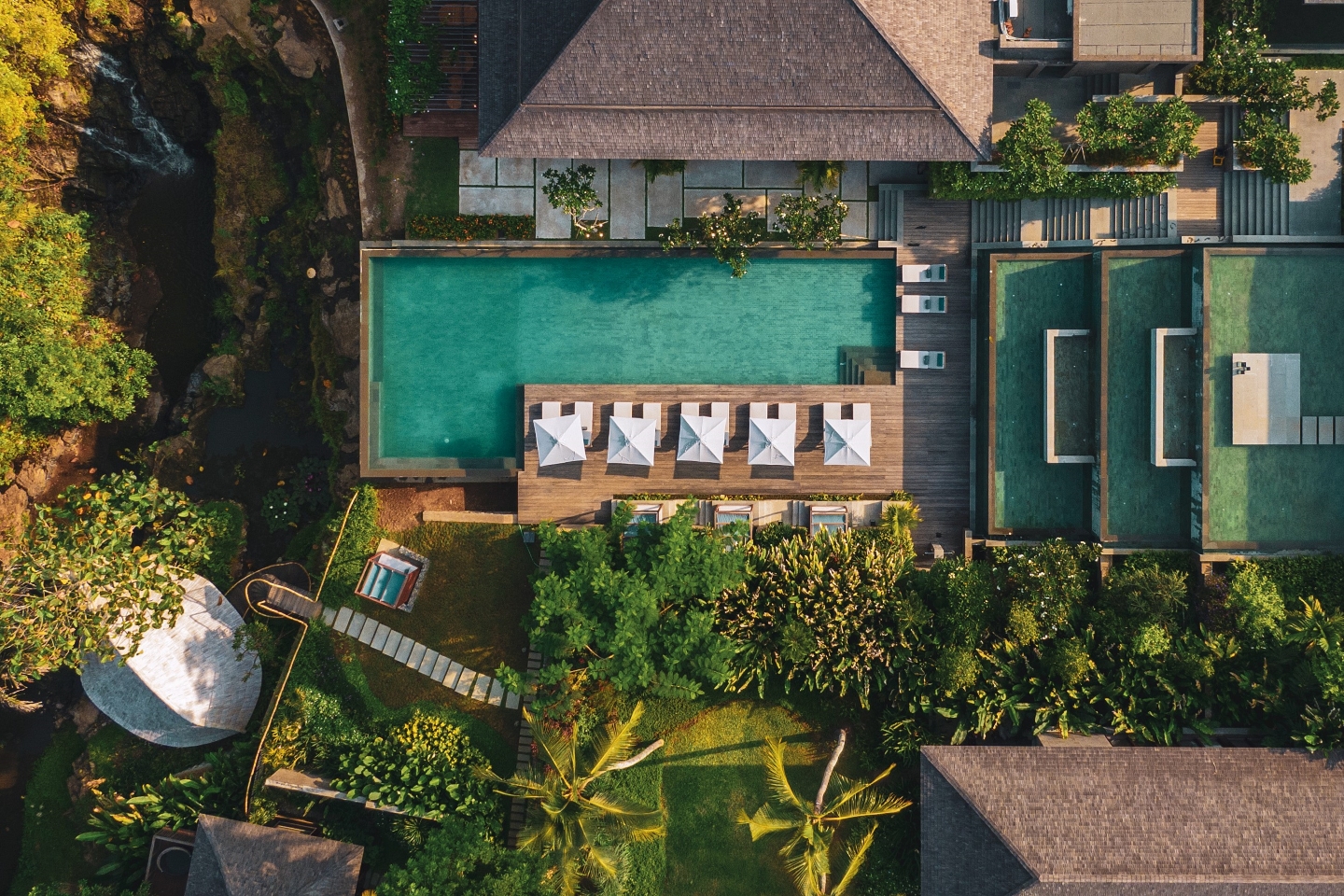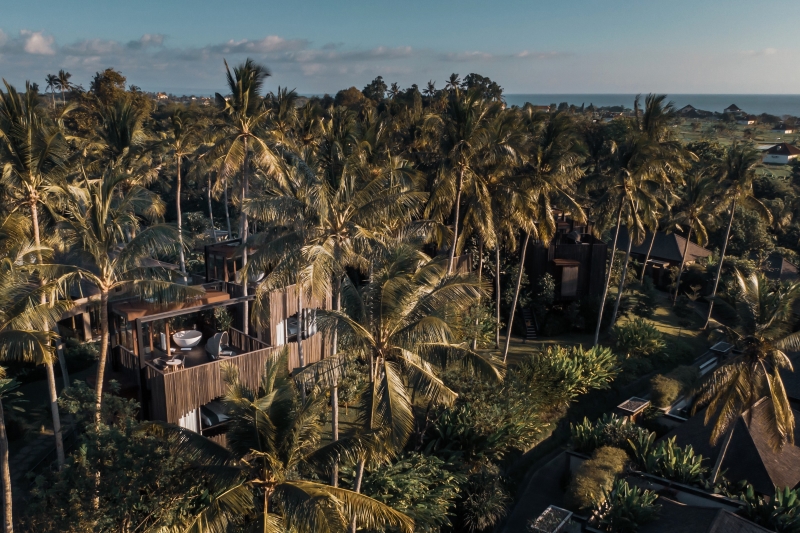
Nirjhara is soothingly-bijou, a jewel box of a resort (All photos: Nirjhara)
Speak to any worldly wise globetrotter about key destinations these days and chances are complaints would top the list when it comes to Bali, Indonesia. Yes, the mystical and palpably spiritual destination still lives up to its original moniker of “Island of the Gods” but of late, the general experience is far from divine. Cases of Bali Belly are rife, trash (yes, the plastic scourge) is omnipresent and traffic is worsening. It made headlines during 2023’s year-end peak period, when travellers had to leave their rides and walk to I Gusti Ngurah Rai International Airport due to chaotic snarls that turned the brief drive to the airport, usually under 30 minutes from Kuta, into hours.
Despite all that, Bali is not ready to be written off just yet. What aids its appeal lies in the mushrooming of unique, standalone resorts that serve as mini destinations themselves. This removes the need to venture out at all, channelling the island’s natural charm and beauty to visitors instead. This slight shift in the itineraries of the Bali-bound may be exemplified by those checking into Nirjhara.
A small 25-key property in Tabanan, not far from the dreamy, Castaway Island-like temple of Tanah Lot, Nirjhara takes its name from the Sanskrit word for “waterfall”. Indeed, the resort is blessed with its own eponymous cascading waters which face the pool and main dining room. It was during a holiday in 1996 that the French-based Tran Tien family ventured to Tabanan, then largely untouched by development, and were inspired to create an eco-conscious space that would blend in with the landscape. Today, almost 25 years on, scion Dimitri Tran serves as managing director and co-owner of Nirjhara, a role he shares with Adrien Portier.
photo_dimitri_adrien_-_original.jpg

Elegant eco-consciousness
“We stumbled upon this place by accident about a decade ago and while it felt a bit remote at the time — tourism was virtually non-existent in Canggu back then — we knew we had come across something unique as soon as we caught a glimpse of the waterfall surrounded by rice paddies, bordered by a gentle river,” says Tran. “It was clear from the start that this land in Kedungu had tremendous potential. It slopes towards a river, offering stunning views of rice fields all around. It is located in a charming village that managed to retain its quaint authenticity and charm and is only a short bicycle ride from the surf breaks of Kedungu Beach. Most importantly, it reminded us of what Bali felt like decades ago when we first visited.”
“The natural features of the site influenced the design of the project from the onset,” Portier adds. “As the land is surrounded by a meandering river forming part of the subak rice field irrigation system which also neighbours a local community that has managed to preserve its authentic Balinese charm, we drew inspiration from traditional villages when conceptualising the layout of the resort. All of our suites are arranged around open spaces and pavilions, reminiscent of traditional bales, places of social interaction, where local communities and families gather to share special moments together.”
This is beautifully reflected in Nirjhara’s spacious common areas and public spaces, located at the heart of the property. Guests are encouraged to come out of their villas and partake in a variety of activities offered each day, interact with the hosts and experience a distinctive facet of Balinese culture, they say.
“We did not want to create yet another eco-lodge,” says Portier. “Our take on sustainability — one of our core values since the inception of the project — is ubiquitous yet discreet and tangible efforts were made throughout the entire process, from design to construction. We believe sustainability and luxury can go hand in hand without having to compromise.”
nirjhara_-_aerial_03.jpg

Showcasing the lush landscape was a priority, and most suites come with either unique views of the waterfall, Bali’s famous emerald rice fields or even a stunning sunset. What many have forgotten — or overlooked — is that Nirjhara was born just before the world went into shutdown. Having opened in January 2020, the fact that the boutique property, which had no recourse to economies of scale, remains in business is testament to its tenacity and solid founding principles.
In today’s world when the “go big or go home” adage is part of life, Nirjhara demonstrates how it is possible to be small and still stand out. The experience is chic yet purposeful, completely in tune with local life, arts and culture. The resort’s structure, for example, was made using a combination of recycled wood as well as natural stones and pays tribute to the acclaimed Indonesian craftsmanship.
Working with artisans from in and around the archipelago, Tran and Portier ensured Nirjhara was accented with bespoke pieces and a soft touch of luxury that brings, for want of a better comparison, Aman or Armani to mind. Upcycled wood cladding, bamboo, handwoven rattan furniture, coconut panelling and more testify to the founders’ thoughtfulness. And to ensure you never forget where you are for a single minute, just look towards the traditional sirap roofing. It is assurance, at a glance.
“I suppose our objective was to carve out a piece of old Bali that didn’t feel out of place in this day and age,” says Tran. “In essence, the hotel is distinctively Balinese in its layout, the views it offers, the general architecture and use of materials and fabrics. But it is also contemporary and design-focused without being ostentatious. It fits in nicely with the surroundings and doesn’t feel like it was transposed from someplace else — it belongs.”
nirjhara_-_canopy_suite_04.jpg

Blue ocean strategy
With Tran’s background in finance and asset management and Portier’s in capital markets, they admit swapping the corporate world for hospitality and real estate was a big shift. “With no prior experience, we had to learn to develop our own resort,” says Tran. “As an independent property, there’s so much you can do when you don’t have to follow the rules and requirements prescribed by large hotel chains for the sake of consistency across a portfolio of hotels. It is liberating for a hotelier and I’d like to think that it makes things more exciting from a guest’s perspective. But Bali has always been a recurring vacation spot over the years, with my family easily spending a dozen summers here since the mid-1990s. So, we really have forged a special relationship with the island over the years.”
While Nirjhara continues to stand alone as a unique property, those who simply need more of its brand of relaxed luxury would do well to know there is another avenue to explore. Enter the Vela, a luxury 50m sailing yacht that is best described as a floating extension of Nirjhara.
“This dates back to 2016 when we began chartering traditional phinisis to explore Komodo National Park, followed by Raja Ampat two years later. We were stunned by the sheer beauty of the landscapes, both on land and underwater,” says Portier. “Dimitri and I were in Bali and working on Nirjhara at the time, so we couldn’t help but ask the crew to take us around the harbours to tour all the other boats we came across.” After visiting about a dozen boats, they realised while there was demand for luxury, very few could truly deliver a refined experience. “We started sketching the layout and requirements of what would eventually become Vela at a Starbucks in Makassar Airport during a layover on our way back from Sorong, Papua.
“Nirjhara doesn’t feel overly built as the villas are integrated into a lush tropical garden and face untouched views of rural Bali. But once our guests step inside their suite, we want them to feel at home in a plush, fresh environment. Similarly, Vela aims to combine Indonesian craftsmanship and modern design. At its core, Vela is clearly a traditional phinisi that celebrates authentic shipbuilding. Once on board, you will enjoy a sense of sophistication that contrasts nicely with the rustic aspect of the boat without contradicting it.”
nirjhara_-_the_retreat.jpg

Work is currently underway to add another 16 villas to Nirjhara’s existing 25, a second restaurant and an extension to the on-site spa. Those wanting to include both Nirjhara and Vela in their upcoming Indonesian itinerary as a sort of traveller’s surf ’n turf combo may wish to consider Portier’s suggestions.
“The main areas where Vela sails to throughout the year are Raja Ampat Marine Park, from November to April, and Komodo National Park, from May to October. Part of the reason these regions feel so special, raw and untouched is their remoteness. There are almost no direct flights to Labuan Bajo or Sorong, so guests usually have to stop at one of Indonesia’s international airports first for a layover before reaching their final destination, or they can make the most of their holiday in the country and stop in Bali for a few days. [And if you are coming from afar], we recommend spending a few days here before heading east to start a Vela charter as it’s a great way to acclimatise to the weather and wean off the inevitable jet lag.”
Don’t mind if we do.
This article first appeared on Aug 19, 2024 in The Edge Malaysia.


